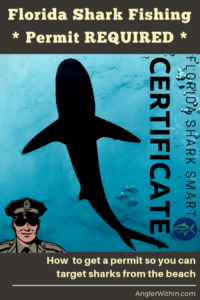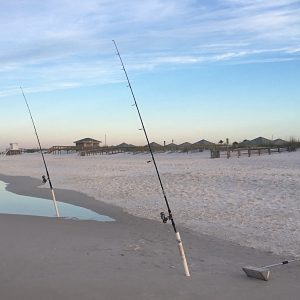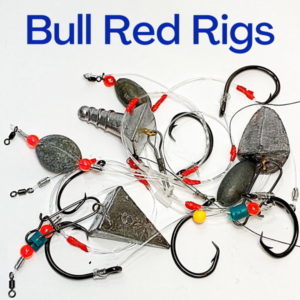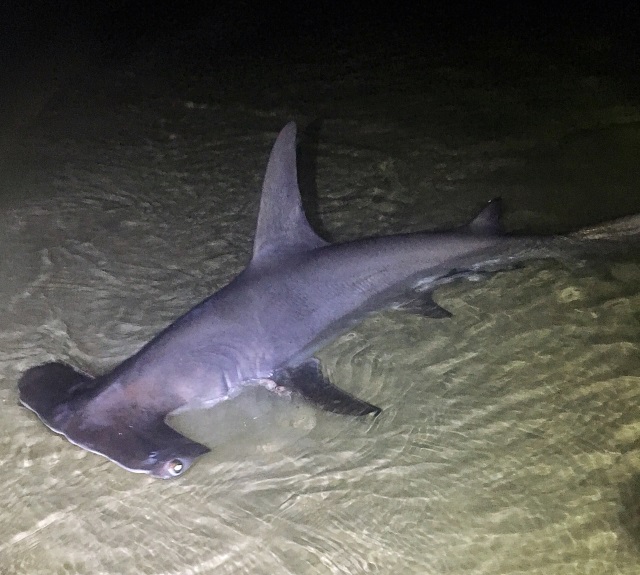
As of July 1, 2019, a permit is now required when targeting, or keeping sharks when fishing without a boat. So, if you plan to go surf fishing for sharks in Florida, you need to do the following 5 things.
First, you need to take the “Shark Course” and score 100%. Once you do that, you can access your certificate of completion, which contains your unique identification code. You can then use this code to obtain a free shark fishing permit from the FWC licensing site. After that, you just need to use appropriate gear, and follow all applicable regulations, as directed in the course. I’ll touch on most of the requirements and regulations below.
*shore – for the remainder of this article, “shore” is defined as any beach, shoreline, jetty, bridge, pier or other structure attached to land
5 Things You Must Do When Surf Fishing For Sharks In Florida
- Take the Shark-Smart course, and pass with 100%
- Access your Certificate of Completion, which contains your unique ID code
- Log onto the FWC licensing site, and use your ID code to get the permit
- Gear up appropriately
- Follow all rules and regulations, as directed in the course
1. Take The Florida Shore-Based Shark-Smart Fishing Course
Who Must Take The Florida Shark Course
If you plan to target, or keep sharks while fishing from *shore, you are required to pass the Florida Shore-Based Shark-Smart Fishing Course. Upon passing, you will receive a certificate of completion.
If you are 16 and older, including those over 65, you are also required to have the no-cost permit (simply passing the course is not enough). Anglers under 16 don’t have to have the permit, but they do still have to take the course, unless they are fishing with another angler who has a permit.
Regardless of whether you are actually targeting sharks from shore or not, these rules still apply if you are doing any of the following from shore. a) using a metal leader longer than 4 feet b) using a fighting apparatus (belt or harness) c) deploying baits by some means other than casting (i.e. kayak) d) using a hook larger than 1.5 inches measured at the widest inside distance.
- Those 16 and older, who plan to target sharks from shore, or keep sharks caught from shore
- Anyone fishing from shore with a wire leader over 4 feet in length
- Anyone using a fighting belt or harness when fishing from shore
- Anyone deploying bait from shore, by any means other than casting (i.e. kayaking), while using a hook 1.5 inches or larger at it's widest inside distance
- Those younger than 16 do not have to have the permit. But, they do still have to have a printed certificate from passing the course, unless they are fishing with another permit holder.
What Is The Florida Shark Course
The course consists of 4 separate modules. You move through the screens of these 4 modules, as a narrator walks you through the material.
- 1. Introduction Module
- 2. Shark fishing regulations
- 3. Shark-smart fishing
- 4. Shark anatomy and identification
Although most of the covered information is listed in the notes section on the module screens, you will find it helpful to also have audio. It helps to follow along with the narrator.
Primary Goals Of The Florida Shark Course
FWC’s intent is to educate us on proper shark id and an any associated regulations. Besides that, they also wish for us to do our best to ensure any released sharks survive. Finally, we are encouraged to follow certain practices to minimize conflict with other beachgoers.
How To Take The Florida Shark Course
Studying for this exam is not required, as you would be expected to easily pick up the answers as you make your way through the course. Although you must score 100% to pass the course, don’t fret, as you can immediately retake a failed exam. And, you don’t have to go through the course modules again before retaking it.
To get started, navigate to the shark course url listed in the steps below. Click the ”Shore-based Shark-Smart Fishing” link. Once there, you will need to create an account. There is an option to log on as a guest, but that won’t allow you take the course. They will require your name and email address to create a login.

After creating an account, you will receive an email containing a link. Follow the link in the email to confirm your registration. Overall, it was a fairly quick and painless process.
Now that you have an account, you must login using the credentials you chose. Once logged in, you will be able to hit the “Enroll Me” button. Proceed from there to complete the exam.
Steps To take the Florida Shark Course
- Navigate to the shark course (http://myfwc.com/sharkcourse)
- Create an account
- Check your email, to complete registration
- Log in using the credentials that you created
- Once logged in, click the "Enroll Me" button
2. Get Your Certificate Of Completion (includes a unique id)
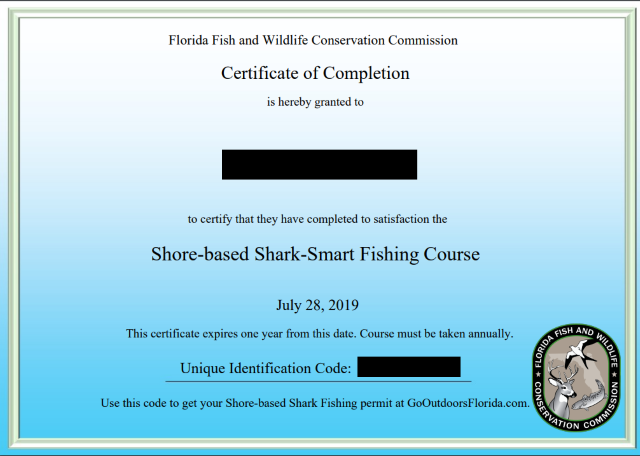
To access your certificate, there is a section on the Florida Fish and Wildlife Conservation Commission page called “Wildlife Training and Certification Courses”. Click the link for the “Shore-based Shark-Smart Fishing“ course that you took. From there, scroll to the bottom of the screen and you should see a link (image below) that will let you access your certificate.

Your certificate can also be found by navigating from the home screen to “My courses” and then to “SSF101″, which is the course name for 2019. I suppose this name could change from year to year. I’ll try to keep this article updated.
Those under 16 years of age, will need to print their certificate, and keep it with them, if fishing for sharks without another permit holder.
If 16 or over, you don’t have to print the certificate, unless of course you want to. But, you will need to write down, or save the unique identification code found on your certificate. This will be needed in order to obtain the permit (next step).
3. Obtain Your Permit From The Licensing Site
Before you can actually get the permit, you will have to have an account set up on gooutdoorsflorida.com. Like me, you may have already done this in the past if you have ever purchased a license online.
I simply entered the last 4 digits of my social security number, last name, and my birthday, and it pulled me right up. I did have to update my address since I recently moved. You will then click “purchase a license”.
Add the shore-based shark fishing permit to your cart. Enter your unique id code from your certificate. Finish your purchase, and print your permit, or download the Fish Hunt Florida app.
If you do not see the option for the permit, it could be that your license has expired. Simply add your desired fishing license to your cart, click to continue shopping, then the permit option will appear in the list.
How To Get A Shore-Based Shark Fishing Permit
- Set up an account on gooutdoorsflorida.com if you have not already done so in the past
- Click "purchase a license"
- Add the shore-based shark fishing permit to your cart
- Enter the unique id code from your certificate
- Complete your purchase
- Print your permit, or download the Fish Hunt Florida app
4. Familiarize Yourself With Shark Anatomy And Identification
Shark ID skills are an important requirement when surf fishing for sharks in Florida. You’ll need to familiarize yourself with several identification factors prior to your trip. Otherwise, you’ll have to treat all unknown species as a prohibited species.
3 Key Features That Help Distinguish One Shark Species From Another
- Tail shape
- Fin placement
- Interdorsal ridge
Tail shape, fin placement and interdorsal ridge are 3 features in particular that will help you differentiate between shark species.
“Fin placement” relates to the variations of where the first dorsal fin lines up with the pectoral fin. You will learn all about the 3 common fin placements when taking the course.
Several common sharks that get misidentified, and can be differentiated by their fin placements are bull sharks, sandbar sharks and lemon sharks.
Tail shape also helps differentiate different species. The 3 tail shapes are “normal”, “elongate” and “lunate”. Some common sharks with “normal” tail shapes are blacktips, bull sharks, tiger sharks and spinner sharks. The main 2 Florida sharks with a “lunate” tail shape are mako and white sharks. Finally, the only shark you would likely encounter with an “elongate” tail shape is the thresher shark.
Finally, interdorsal ridge is another key feature that helps with proper shark id. Most sharks with a visible interdorsal ridge (ridgeback sharks) are a prohibited species.
The 3 pairs of sharks listed below can be difficult to properly identify from each other. It is especially important to be able to tell the difference between these, as the regulations for each are different. So, you should spend some time with the FWS resources linked below, so that you can properly identify these species.
3 Pairs Of Sharks That Are Difficult To Differentiate From Each Other
- Bull Sharks and Lemon Sharks
- Blacktip Sharks and Spinner Sharks
- Hammerheads and Bonnethead Sharks
Besides taking the course, FWC also has other shark id materials that will help you. You can get a copy of the FWC field guide here (scroll to page 43): FWC Identification Guide
And, here are a couple handy pdfs that will help with proper shark id: Know Your Florida Fish: Sharks and FWC Guide to the HMS Sharks of Florida
I recommend printing these pdf’s and keeping them with your fishing tackle.
5. Gather Required And Recommended Gear
It’s a good idea to plan ahead so that you can be sure to have all recommended, and required gear on hand. Some things you will want to be sure to have are, some type of cutters that can cut through the hook or leader, a means of measuring your shark, proper hooks, a hook removal tool, and a bag to carry out any trash. I would also recommend taking some printouts, as provided by FWC, for shark identification.
Required Gear When Surf Fishing For Sharks In Florida
- Non-stainless, non-offset circle hooks
- Cutters capable of cutting the hook, or leader (bolt cutters, wire cutters, etc)
- Hook and Line only
Recommended Gear When Surf Fishing For Sharks In Florida
- A de-hooking device - I personally like these
- hooks that have had the barb filed down
- A bag for your trash
If you’re a first timer, in the process of gearing up to surf cast for sharks, the following article may help you in choosing a shark rod. Top Criteria To Consider When Choosing A Surf Rod
6. Follow All Regulations And Best Practices From The Course
See below for the list of regulations that you must follow when targeting sharks in Florida. I tried to also list all best practices that you should be aware of.
Some Regulations To Follow When Surf Fishing For Sharks In Florida
- Some form of cutters are required, which can cut the hook or leader
- Chumming is prohibited from the beach
- Abide by size limits for applicable species
- Abide by special regulations for *prohibited species
- Treat any unidentifiable shark as a prohibited species
- Non-offset, non-stainless steel circle hooks are required
- Special care must be taken for prohibited species, including an immediate release. The entire shark must also remain in the water at all times.
- Any accidentally caught sawfish or manta ray must be released immediately by cutting the hook or leader with no delay
No Minimum Size Limit On These Shark Species
- Blacktip
- Bonnethead
- Atlantic Sharpnose
- Blacknose
- Finetooth
- Smooth dogfish
- Florida smoothound
54" Fork Length Minimum Size Limit On These Shark Species
- Bull
- Spinner
- Oceanic whitetip
- Nurse
- Blue
- Thresher
- Porbeagle
Note: The bag limit for sharks is 1 per person per day
Additional Best Practices While Surf Fishing For Sharks In Florida
- Plan ahead to avoid congested beaches, and avoid fishing near swimmers
- when fishing at night during sea turtle nesting season, only use red lights
- Clean up after your outing
- If a shark dies that you try to release, call the fish kill hotline at 800-636-0511
- Consider fishing with a team that knows how the process will play out
- File down the barbs of your hooks
- Use heavy tackle to minimize fight time, so as to not tire the shark completely out. 80 lb test is preferred.
- Keep sharks in the water when possible; and always keep prohibited species in the water (especially their gills)
- Do not sit on the sharks back for photos
- Treat any unknown shark as a prohibited species
- Consider using a de-hooking device, but only if it does not extend release time
- If you plan to take photos, have your photographer ready at a moments notice, so as to quicken the release
Conclusion
Surf fishing for sharks is a beloved Florida past time, and we should all be willing to do whatever is takes to ensure it lives on. Overall, I think this permit is a good thing, as many of us could use an annual refresher, and I’m sure rules will also change from year to year.
Remember, this course must be re-taken annually. You can’t simply renew the permit every year.
Here is the link to the course: myfwc.com/sharkcourse
Good Luck!
Augustus Clay
